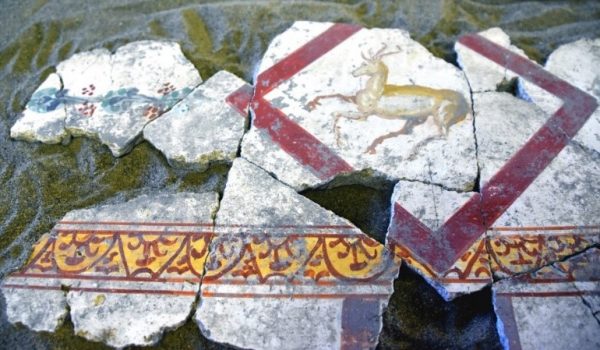THE RePAIR PROJECT BEGINS – ROBOTICS AND DIGITISATION AT THE SERVICE OF ARCHAEOLOGY
Thanks to state-of-the-art robotic infrastructure, thousands of fresco fragments from the House of the Painters at Work and the Schola Armaturarum will be reassembled.
September 1st 2021 saw the launch of the 'RePAIR' project - an acronym for Reconstructing the Past: Artificial Intelligence and Robotics meet Cultural Heritage. State-of-the-art technology will, for the first time, be employed in the physical reconstruction of archaeological artefacts, which are mostly fragmentary and difficult to reassemble.
Thousands of fragments, akin to small pieces of a puzzle, will be reassembled with the aid of a robotic infrastructure, equipped with mechanical arms capable of scanning the fragments, recognising them via a 3D digitisation system, and then placing each one in the correct position. While the fragments are being recognised and scanned, the precision mechanical arms and hands manipulate and move them with the aid of highly advanced sensors that are able to avoid causing the slightest damage to the artefacts.
The subject of this experimentation will be the frescoes from the ceiling of the House of the Painters at Work in the Insula of the Chaste Lovers, which were damaged during the eruption of AD 79 and later reduced to fragments by the bombings of the Second World War.
A group of experts on wall paintings from the University of Lausanne, led by Professor Michel E. Fuchs, has been working on this extraordinary context since 2018, with a program of study and manual reassembly based on analysis of the various morphological, stylistic and technical aspects of the fragments. The launch of the new project, which will proceed alongside and co-ordinated with the ongoing work of the Swiss team, will therefore make it possible to compare the two working methodologies and their respective results.
The second case study will focus on fresco fragments from the Schola Armaturarum, which resulted from the collapse of the building in 2010 and which have not yet all been put back into place. These are two iconic examples of great frescoes of world cultural heritage which are in a fragmentary state and which are preserved in the warehouses of the Archaeological Park of Pompeii.
The operation makes use of the interdisciplinary contribution of scientific and research institutes which operate in the fields of computer vision, robotics and artificial intelligence, together with the fundamental contribution of archaeology and the conservation of cultural heritage.
Alongside the Archaeological Park of Pompeii, the partners of the 'RePAIR' project include: The Ca’ Foscari University of Venice (coordinating body), the Ben-Gurion University of the Negev of Israel, the IIT - Italian Institute of Technology, the Associacao do Instituto Superior Tecnico Para a Investigacao e Desenvolvimento of Portugal, the Rheinische Friedrich Wilhelms Universitat of Bonn in Germany and the Ministry of Culture. The project has received funding from the Horizon 2020 research and innovation program of the European Union, under Grant Agreement no. 964854.
“Amphorae, frescoes and mosaics are often brought to light in a fragmentary state, only partially intact or with many pieces missing," - declares Gabriel Zuchtriegel, Director of the Archaeological Park of Pompeii - "When the number of fragments is very great, with thousands of pieces, a manual reconstruction and understanding of the connections between the fragments is almost always impossible or else very laborious and slow. As a result, various finds spend a long time lying in archaeological warehouses, unable to be reconstructed and restored, let alone to be returned to public view. With the aid of robotics, digitisation and artificial intelligence, the RePAIR project, as the result of technological competence and research, seeks to solve an age-old problem".
"From the scientific and technological point of view, the project raises important challenges, and to address them we will use the most advanced techniques in the field of artificial intelligence, artificial vision and robotics" - adds Professor Marcello Pelillo, coordinator of the project and Professor of Artificial Intelligence at the Ca' Foscari University of Venice.


